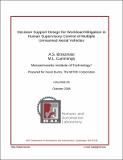| dc.description.abstract | As UAVs become increasingly autonomous, the multiple personnel currently required to operate
a single UAV may eventually be superseded by a single operator concurrently managing
multiple UAVs. Instead of lower-level tasks performed by today’s UAV teams, the sole operator
would focus on high-level supervisory control tasks such as monitoring mission timelines and
reacting to emergent mission events. A key challenge in the design of such single-operator
systems will be the need to minimize periods of excessive workload that could arise when
critical tasks for several UAVs occur simultaneously. To a certain degree, it is possible to predict
and mitigate such periods in advance. However, actions that mitigate a particular period of high
workload in the short term may create long term episodes of high workload that were previously
non-existent. Thus some kind of decision support is needed that facilitates an operator’s ability to
evaluate different options for managing a mission schedule in real-time.
This paper describes two decision support visualizations designed for supervisory control of four
UAVs performing a time-critical targeting mission. A configural display common to both
visualizations, named the StarVis, was designed to highlight potential periods of high workload
corresponding to the current mission timeline, as well as “what if” projections of possible high
workload periods based upon different operator options. The first visualization design allows an
operator to compare different high workload mitigation options for individual UAVs. This is
termed the local visualization. The second visualization is indicates the combined effects of
multiple high workload mitigation decisions on the timeline. This is termed the global
visualization. The main advantage of the local visualization is that options can be compared
directly; however, the possible effects of these options on the mission timeline are only indicated
for the individual UAV primarily affected by the decision. For the global visualization, different
decisions can be combined to show possible effects on the system propagated across all UAVs,
but the different alternatives of a single decision option alternative cannot be directly compared.
An experiment was conducted testing these visualizations against a control with no visualization.
Results showed that subject using the local visualization had better performance, higher
situational awareness, and no significant increase in workload over the other two experimental
conditions. This occurred despite the fact that the local and global StarVis displays were very
similar. Not only did the Global StarVis produce degraded results as compared to the local
StarVis, but those participants with no visualization performed as well as those with the global
StarVis. This disparity in performance despite strong visual similarities in the StarVis designs is
attributed to operators’ inability to process all the information presented in the global StarVis as
well as the fact that participants with the local StarVis were able to rapidly develop effective
cognitive problem strategies. This research effort highlights a very important design
consideration, in that a single decision support design can produce very different performance
results when applied at different levels of abstraction. | en |
